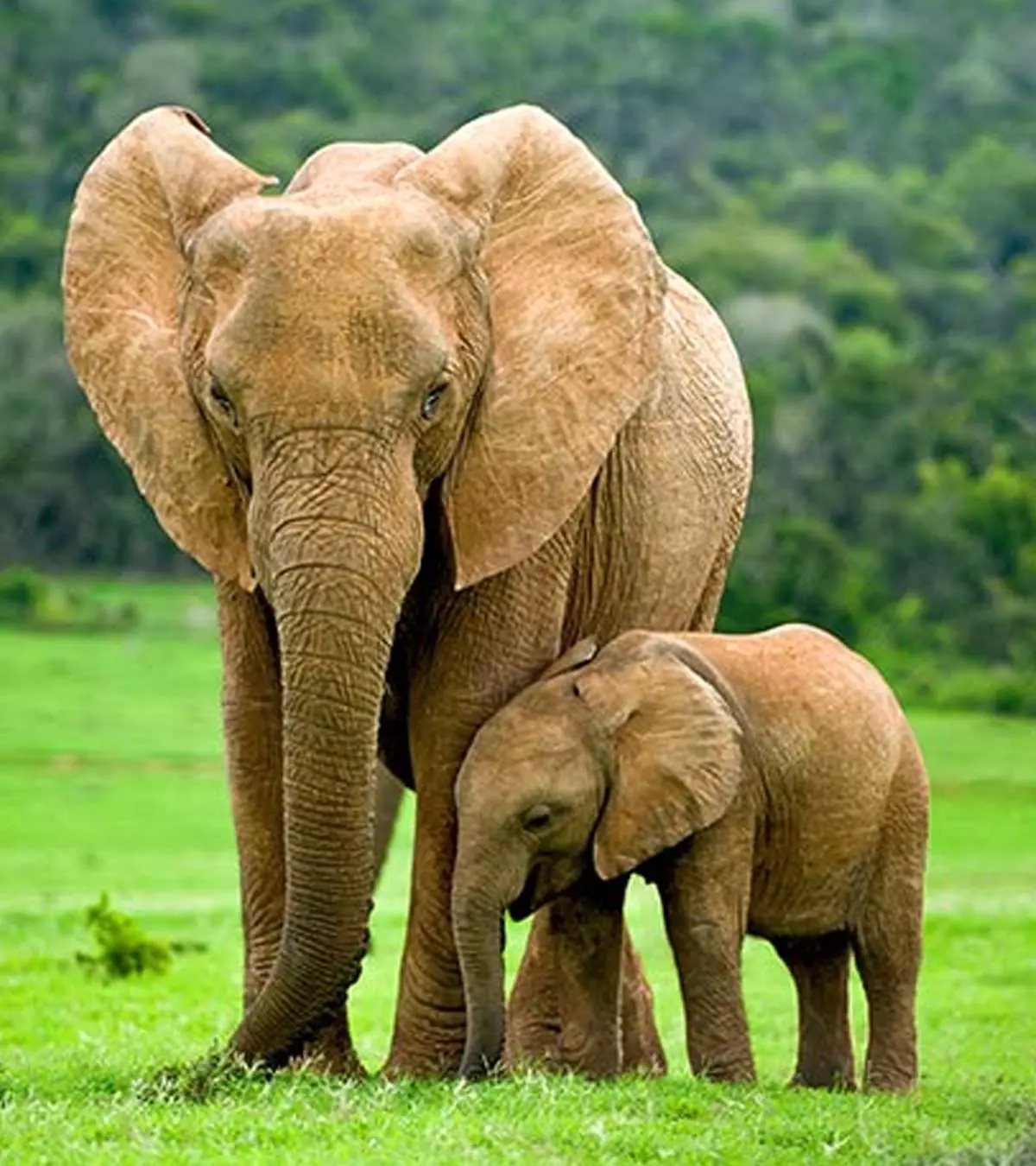
Image: ShutterStock
Elephants are mighty animals whose size, shape, features, and nature amaze children. So, we have come up with some facts about elephants for children to help them learn more. Although elephants may look gigantic and intimidating, they are friendly, and children love them. It can be fun for children to feed them as they pick up the food with their long trunks to put in their mouths. With their unique build and shape, elephants grab your child’s attention amidst other wild animals. So, here’s our list of some interesting facts about elephants that your little one would love to learn about. If your child has several questions about them, you don’t need to fret. Read on and have a playful quiz round with your children.
Key Pointers
- Elephants are the largest land mammals on earth.
- Their distinctive features include long trunks, large ears, and tusks.
- Elephants communicate with each other through trumpet calls or growls.
- Herbivorous in nature, they consume up to 300 kg of food and 160 liters of water daily.
- Climate change, hunting, and poaching have significantly reduced their population each year.
25 Incredible Elephant Information and Facts For Kids
1. What is an elephant?
The name elephant is derived from the Greek word ‘elephas’ which refers to ‘ivory’. The elephant is the largest mammal living on land. According to National Geographic’s website, African elephants grow up to around 8.2 to 13 feet from shoulder to toe, while Asian elephants can grow up to 6.6 to 9.8 feet (2 to 3 m) from shoulder to toe. African elephants weigh anything between 2,268 to 6,350 kg while Asian elephants weigh around 2,041 to 4,990 kg [1].
2. What are the different types of elephants?
Based on the region they are found in, elephants are categorized into two types: African and Asian. Loxodonta Africana is commonly known as African elephants, and Elephas Maximus are commonly known as Asian Elephants.
3. Where do elephants live and what kind of climate do they prefer?
African elephants are mostly found in sub-Saharan Africa. They also live in the rain forests of Central and West Africa and the Sahel desert in Mali. African elephants usually prefer the Savanna region as it is full of grass with plenty of trees scattered around. And, the Savannas receive around 20 to 50 inches of rainfall every year. The temperature in the savanna is anything between 60 and 75 degrees. The Savanna region gets rain for only 6 to 8 months in a year.
Some African elephants live in deserts and mountains. Elephants living in deserts walk up to 60 miles a day in search of food and water. They also dig holes in the ground for water. In the case of lack of green cover, elephants depend on salt licks and water with higher amounts of minerals for survival.
Asian elephants can be found in thorn-scrub forests of Sri Lanka, Southern region of India and Thailand. These elephants prefer hot, humid, and grassy areas around jungles. They are found in regions full of grass, trees, and shrubs that make it convenient for them to feed on. Asians elephants migrate according to the time of the year. January to April is generally the dry season when elephants migrate to river valleys in search of water from the rivers. The next 4 months, May to August they shift to the tall grass forests, where the ongoing rainy season gives rise to plenty of the grass cover. The last 4 months of the year, September to December, elephants spend time in the short grass of the open forests.
 Trivia
Trivia4. What do elephants eat?
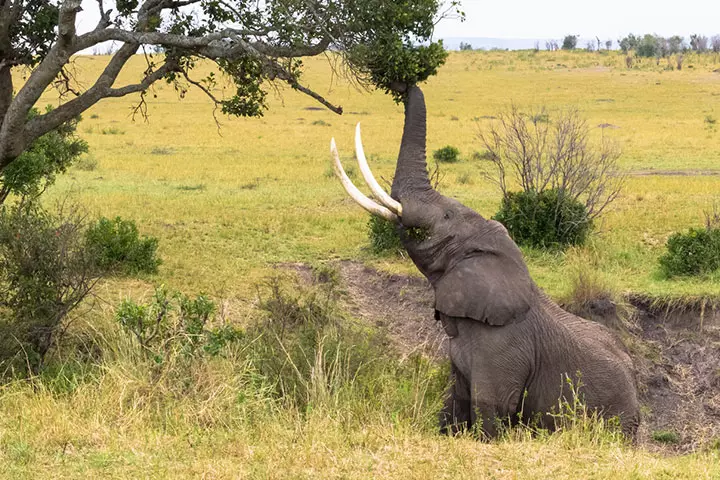
Image: IStock
Elephants are avid eaters and spend up to 16 hours a day eating. A fully grown adult elephant can consume around 300 kg of food and 160 liters of water every day. On an average, African elephants can eat up to 250 kilograms of food while the Asian elephant can eat up to 150 kilograms of food. They are herbivoresiAnimals whose food source is only plants and only consume small plants, grasses, roots, fruits, twigs, and bark. Elephants love eating tree bark the most because it is rich in calcium and roughage that helps in better digestion. It uses its tusk to carve into the trunk and tear off strips of bark. Elephants dig into the earth to obtain salt and minerals. If the weather is dry or there is less grass to eat, elephants will eat almost any kind of vegetation available. They will dig for roots and water using their tusks. Most of the food eaten by elephants is left undigested, and their excreta usually serves as food for monkeys and other animals.
When in captivity, elephants are mostly fed cabbage, lettuce, sugar cane, and fruits like apples and bananas. However, hay is the staple diet of an elephant and is fed that on a regular basis. Sugarcane is the favorite food of the Indian elephant. Additionally, it also enjoys eating a lot of crops which is one of the main reasons why elephants pose a nuisance running in fields and rice paddies looking for food.
Raji, a blogger and traveler enthusiast, shares her experience visiting Sakrebyle Elephant Camp. She says, “Having emerged from the river, the elephants were now being oiled to keep them cool, even as their food was being prepared. They are fed in an interesting way – chunks of coconut flesh and jaggery are wrapped into a bundle using hay, which the giants gleefully devour. A few of the youngest elephants were play-fighting and chasing each other, only to be firmly nudged by an adult if they got too boisterous (i).”
5. What do elephants drink?
African elephants drink 60 liters of water a day while the Asian elephant drinks 40 liters of water on an average per day. A fully grown male elephant can drink up to 212 L (55 gallons) of water within five minutes. Elephants prefer living near water bodies because they consume water in arge quantities
6. What is an elephant’s anatomy?
An elephant’s body structure is well adapted to sustain in the harsh climate of Africa and Asia. Let’s have a look at the different parts of an elephant’s body and their uses.
Long Trunk: An elephant’s long trunk is an extension of its upper lip and nose. Its trunk consists of around 1,00,000 muscles and can bend and twist easily. It is 2 meters long with a weight of around 140 kg. Other than breathing air, an elephant’s trunks help it do a number of other things such as:
- When in danger, the elephant first raises its trunk to smell and understand its threat.
- It brings water and food to its mouth.
- It stores water to drink later or even to sprinkle on the body while bathing or cleaning. A trunk can hold about six liters of water.
- It helps to knock down trees
- It makes sounds that enable an elephant to communicate with other elephants.
- It is used to lift and move their little ones.
- It is used to beat an unfamiliar ground to check if it is hard enough for the elephant to walk on it.
Big Ears:
Elephants have large ears that enable them to catch the slightest of sound. The African elephant’s ears are almost 3 times larger than an Asian elephant’s ears. Its ears help with the following functions:
- Elephants cannot sweat. Its ears have numerous capillariesiThe smallest type of blood vessel connecting an artery to a vein and extending all across the body to provide nutrients to the organs and veins that filter hot blood in the arteries and send cool blood to the body thus maintaining its body temperature.
- Since the elephant’s ears are hyper-sensitive, it easily communicates with other elephants over large distances.
- If ever confronted by a dangerous attacker, the elephant spreads its ears wide to scare the attacker by appearing larger.
Sturdy Feet:
An elephant has two front feet and two back feet. However, not all elephants have the same number of toes on each foot. African elephants have four toes on their front feet, while Asian elephants have five toes. Similarly, African elephants have three toes on their back feet, whereas Asian elephants have four toes. Its back legs appear longer than the front legs because of its high shoulders. Elephant’s toes are not visible because they are hidden inside their feet with only toenails visible on the outside. Their feet have fatty connective tissue that acts like shock absorbers enabling the elephant to move soundlessly. The ridges and pits on the feet help the elephant to maintain stability while moving around. The shape of the elephant’s footprint indicates the gender of the elephant. Female elephants leave rounded footprints while male elephants tend to have oval shaped footprints. Footprints can also be used to determine the animals age. If the footprint is well defined then, the elephant will be young while undefined footprints usually belong to older elephants since their feet have worn out over the years.
Sensitive Skin: Elephant skin is thick and tough except for a few certain regions such as its back and sides. The skin near its ears, eyes, chest, and shoulders is the thinnest. An elephant’s skin is sensitive and needs to be protected from the sun. It enjoys rolling in muddy water as it rubs the mud on its skin to protect it from getting sunburned. Female elephants always shadow their offspring to shield them from the harsh sun. The elephant’s skin is super sensitive to the extent that it can feel even a tiny fly sitting on it. The wrinkles on the elephant’s skin help it maintain its body temperature. These wrinkles expand in water allowing more skin surface to absorb moisture. It traps water and keeps the elephant cool even after it is out of the water. Skin is also a determining factor of the elephant’s descent. Asian elephant’s skin is finer as compared with African elephants. It may also be colorless except for the ‘white spots’ on the elephant’s ears and forehead.
 Did you know?
Did you know?Double Tusks: The white curved teeth sticking out of an elephant’s mouth is its tusk. They are made of ivory. Male African elephants have long and large tusks while female African elephants have short tusks that are hardly visible. Moreover, male elephants generally have heavier, longer, and thicker tusks as compared to female elephants. Among Asian elephants only male elephants have tusks whereas most female elephants have small tusk-like teeth. Tusks grow throughout the life of an elephant. Just like how humans have one dominant hand either left or right, elephants also have their preference for tusks. The tusk the elephant favors more is shorter because it is used more often for daily tasks.
Tusks are used for the following purposes:
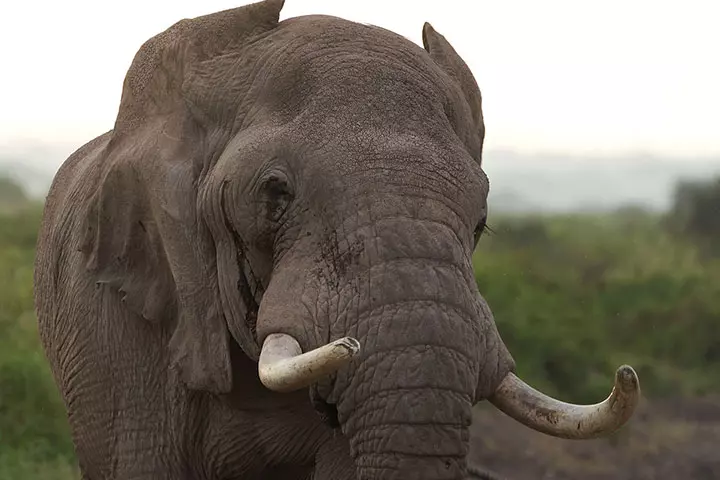
Image: IStock
- Fight and defend itself
- Peel off bark of trees
- Crack open hard-shelled fruits
- Dig in the ground for food, minerals and salts
- Carry heavy loads
- Clear debrisiThe pile of trash after something has been broken or crushed
Conveying Teeth:
Elephants have a unique set of teeth wherein the teeth start growing from the back moving towards the front. Elephant’s teeth are large and flat, ideal for chewing plants and grass. As each tooth gets worn out, a new tooth replaces it. An elephant has 24 teeth but can use only two at a time. The teeth of African elephants have diamond shaped ridges running across the teeth while Asian elephants have parallel ridges.
Large Brain: The elephant is one of the most intelligent animals. Its brain is 4 times the size of an average human’s brain and is the largest amongst all mammals. The female elephant’s brain is smaller than the male elephant’s brain. However, despite the difference in the brain size, female elephants are believed to be equal to or even smarter than male elephants. Despite the enormity in size, an elephant’s brain occupies a small area at the back of its skull.
Eyes: The website Seaworld.org reports that elephant eyes are about 3.8 cm (1.5 in.) in diameter. The elephant’s eyesight is rather poor, and their vision range is barely up to 20 meters. Their eyelashes are long so as to protect the eyes from sand and dirt. The elephant not only has an upper and lower eyelid but also has an extra third eyelid that moves vertically across the eye. The main purpose of this eyelid is to protect the eye when performing daily functions such as feeding, bathing, and dusting. Some elephants develop a white ring around the iris as they grow up. However, this white ring does not affect the eyesight of the elephant. The location of the eyes, that is, to the side of the head, gives the elephant better peripheral vision.
Tail: An elephant’s tail is usually 1.3 m long. The skin of the tail coarse and it has wire-like hairs. Elephants have good control over their tail and use them to fend off insects and flies.

Image: Shutterstock
7. How do elephants live and survive in their natural habitat?
Elephants do not have predators. They have a lifespan of around 60 to 70 years. Considering their huge size, they require a large area of land to live, breed and thrive. Other than food and water, elephants need favorable climates to survive, and Asian and African climates best suit the elephant which is why they are majorly found in these two continents.
Elephants live in herds. But male and female elephants live differently. Female elephants live with other female elephants, mostly their mothers and aunts while male elephants prefer living independently. The female group is mostly led by the oldest female. Females interact with males or even other female elephants on the borders of their groups. Males generally leave the herd between the age of 12 to 15. Males have to fight it out with other males to win the attention of the female elephant. In most cases, the older elephant manages to outshine the younger ones.
8. How do elephants communicate with each other?
Elephants communicate with each other through a variety of sounds. They usually call each other with a trumpet call i.e. the sound made by blowing air through the nostril or growl. When confronted by another animal or when under any threat, they growl. They have the ability to communicate over large distances with their body language and low-frequency subsonic rumbling, also known as infrasound. They mostly use this when moving around.
9. How do elephants spend their time?
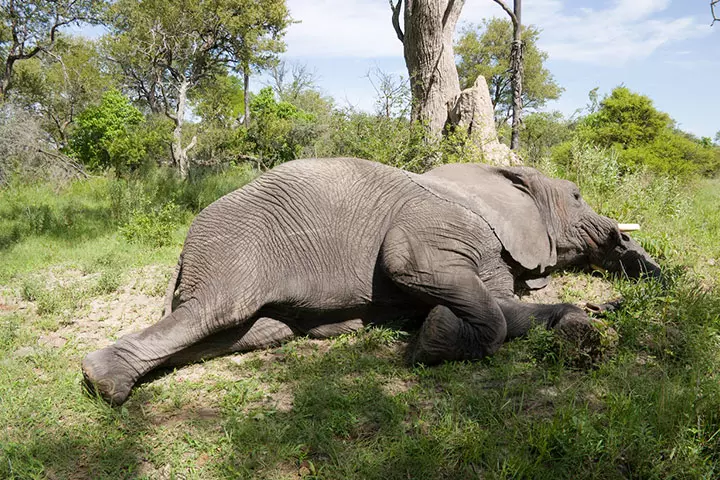
Image: IStock
Elephants usually eat, sleep, socialize, and roam around during the day. They are known for being playful—they often take part in dust bathing, swimming, and playing. They also bathe in water or mud and explore their surroundings using their trunks as a navigation guide.
10. Why are they endangered?
The hunting of elephants by poachers for their ivory tusks and the destruction of green cover, mainly in Asia, have caused a loss of the elephant’s natural habitat, leaving no place for its population to grow and flourish. These factors have led to a rapid decrease in the elephant population, making it an endangered animal. As per the World WildLife website, the African elephants’ range shrank from 3 million square miles in 1979 to just over 1 million square miles in 2007 [2].
11. How many elephants are left in the world?
As per WWF.Panda.org, in the 20th century, there were around 3-5 million African elephants which have reduced to 470,000 in the present day [3].
12. What are we doing to save the elephant from extinction?
To save the elephants, governments of several countries have banned the trade of ivory and ivory products and have also declared hunting of elephants as a punishable offense. You can also help but say no to ivory products and jewelry. You can donate to several NGOs that work towards the preservation of elephants. Lastly, you can support the movement against China demanding it to discontinue its use of ivory [4].
13. What is the largest species of elephant?
The African elephant is the largest elephant species. Female African elephants typically weigh between 2,000 and 3,500 kilograms, while males surpass them in size, ranging from 4,500 to 6,100 kilograms. Distinguishing features between the sexes encompass head shape, forehead width, back configuration (saddle-back vs. straight back), and tusk size. Known for their high intelligence, African elephants boast a large and intricately convoluted neocortex, a trait shared with humans, apes, and some dolphin species. These intelligent creatures exhibit minimal sleep, averaging only 2 hours within a 24-hour cycle. African elephants thrive in various African ecosystems, including savannas, scrub forests, rainforests, occasional deserts, woodlands, and beaches. However, protected sanctuaries serve as their main habitats due to persistent threats from poaching.
14. What are the differences between African and Asian elephants?
- An African elephant’s head is rounder than an Asian elephant’s head. The African elephant’s head is twin-domed with a slight dent in the center.
- African elephants have bigger ears than Asian elephants. In fact, it is said that an African elephant’s ears resemble the shape of Africa, and it is big enough to cover its neck. They have big ears because they live in a hot climate, and their ears help them cool off their body. Asian elephant’s ears are said to resemble the map of India. Their ears are small and curvy because they live in a slightly cooler climate.
- The African elephant’s skin is looser and has a lot of wrinkles. The skin of an Asian elephant is smoother with fewer wrinkles.
- The tip of the trunk of an African elephant has two fingers while the Asian elephant has only one finger.
- The shoulder is the highest point of the African elephant. For the Asian elephant, its highest point is its back.
- The shape of the African elephant’s back is concave while the Asian elephant generally has convex or an erect back.
- The belly of the African elephant bends more towards the hind legs. The Asian elephant’s belly is mostly straight or loose in the middle.
- Though both the types are herbivores, the African elephant’s diet mainly consists of leaves, while the Asian elephant eats a lot of grass.
- The number of ribs in an elephant generally differs on an individual level. However, African elephants have up to 21 pairs of ribs while Asian elephants have around 20 pairs.
Elephant Facts For Kids
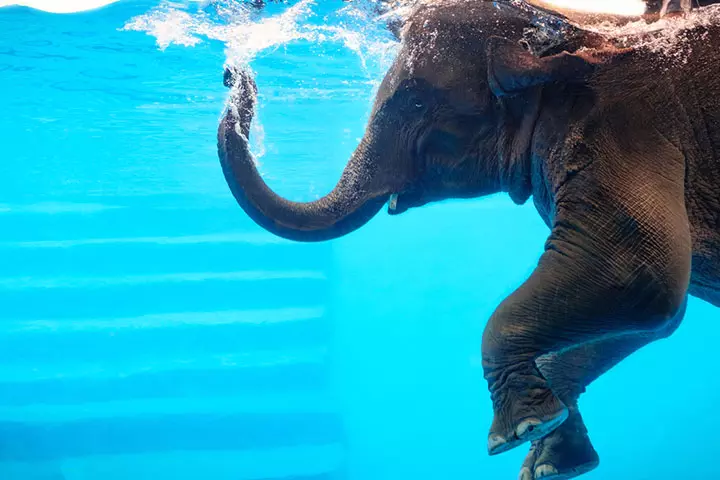
Image: IStock
14. Baby elephants are born blind.
15. Elephants are the only mammals that are unable to jump, trot, or gallop. But they do know how to swim.
16. Elephants are afraid of bees.
17. Female elephants have the longest gestation period and are pregnant for almost two years.
18. Elephants use sand as sunscreen to protect themselves from getting sunburned.
19. After humans, elephants are the only animals to have chins.
20. Elephants have a strong sense of smell and can detect water from a distance of 12 miles.
21. Like humans, elephants also have greeting ceremonies for a friend who returns to their group after a long time.
22. Elephants are intelligent and emotive. They can express grief and compassion. They learn quickly and are very playful.
23. Elephants can identify themselves in a mirror.
24. An elephant’s trunk can sense the size, shape, and temperature of an object.
25. A mother elephant often appoints multiple babysitters to look after her little one so she can eat enough to be able to feed her child.
Frequently Asked Questions
1. What are baby elephants called?
Baby elephants are called calves. Despite being the largest land animals on earth, they are only around 200 to 300lbs when born.
2. What is the favorite fruit of elephants?
Banana is one of the elephants’ favorite fruits. They also love jackfruit, apples (except for green apples), pineapple, and watermelon.
3. Do elephants sleep standing up or lying down?
Elephants can sleep in both a lying down position and a standing position. Studies have indicated that elephants in their natural habitat often sleep while standing up, which allows them to conserve energy and avoid the effort required to rise from a lying position (2).
4. How fast do elephants run?
Elephants are not known for their speed, but they can run surprisingly fast when necessary. They can reach speeds of up to 40 miles per hour (3).
5. Do elephants cry a lot?
Contrary to popular belief, elephants do not cry emotional tears as humans do. The watery substance sometimes seen in their eyes is believed to be a secretion that helps to keep their eyes moist and protected. Scientists have found evidence suggesting that elephants can experience grief and may exhibit various responses to it (4).
6. Do elephants get angry?
Like many animals, elephants can experience a range of emotions, including anger and rage (4). When elephants feel threatened, territorial, or provoked, they can display aggressive behavior.
7. Are elephants nice to humans?
In general, elephants can be kind and affectionate towards humans, especially when treated well, and have positive interactions with humans. However, it is essential to remember that elephants are wild animals and should be observed and interacted with in a responsible and safe manner.
8. Why are elephants considered to be important animals in some cultures?
Elephants are considered important animals in many cultures for several reasons. They are often seen as symbols of strength, wisdom, and power. In some cultures, elephants are associated with religious and spiritual beliefs and are revered as sacred creatures.
9. How long can an elephant’s tusks grow?
An elephant’s tusks can grow continuously throughout its lifetime. The permanent tusks, which replace the temporary ones between the ages of six and 13 months, have an average growth rate of about 17 cm per year. Adult African male elephants can have tusks that reach impressive lengths up to 350 cm (5).
From their massive body size to how they walk and squirt water from their truck, there are so many things about elephants that fascinate kids. To engage your child further, consider showing them how to draw an elephant for kids, which can make learning about these creatures even more enjoyable. To help your child know more about this gigantic creature, share these interesting and informative facts about elephants for kids with them. These incredible facts share details about an elephant’s average size and weight and its types. They also talk about elephants’ diet, habitat, and communication skills to take your child a step closer to elephants and their mesmerizing world.
Infographic: Elephant Facts For Children
Elephants are known to be the largest land animals to exist on the surface of the earth. These mighty creatures can easily attract your little one’s attention. So, why not help them learn more about the magnificent creature and expand their knowledge about their surroundings? To help you do so, we have the following infographic with a list of interesting facts you can share with your little one. Explore along! Illustration: Momjunction Design Team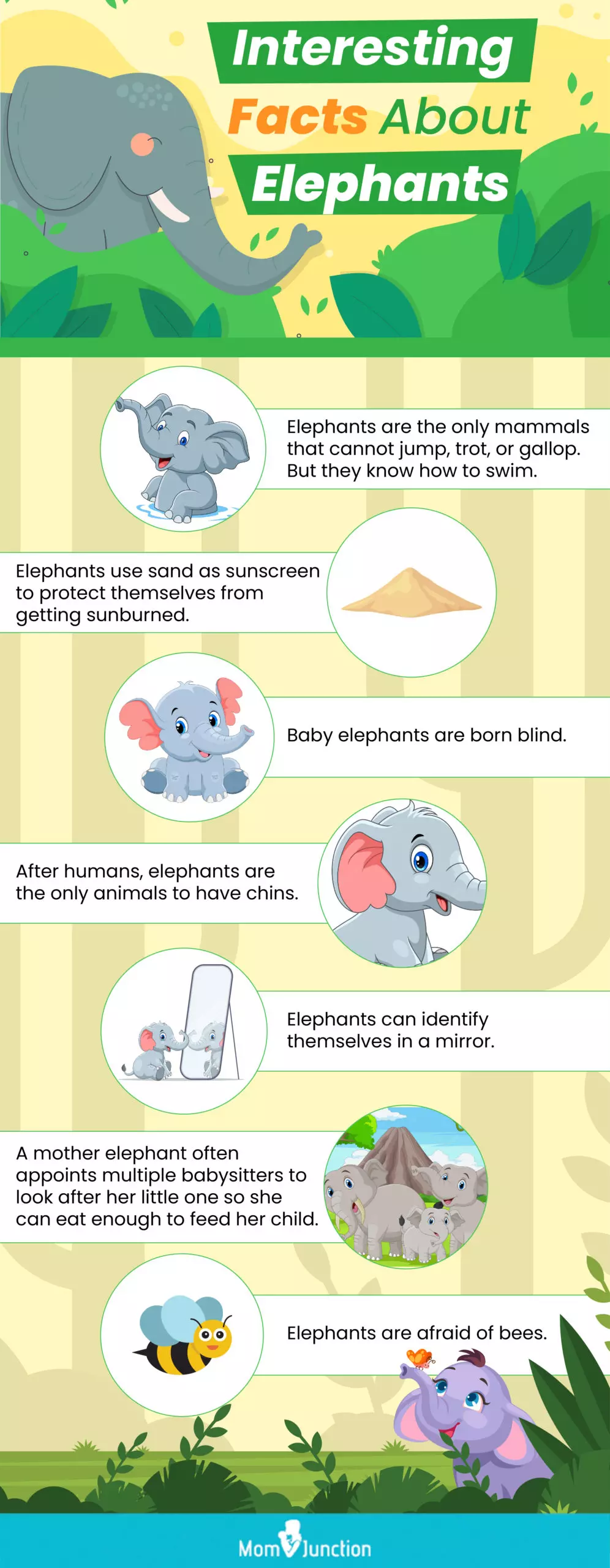
Illustration: Fun And Amazing Facts About Elephants For Kids

Image: Stable Diffusion/MomJunction Design Team
Elephants are majestic animals. Here are some facts you can share with your little know to increase their knowledge about elephants!
Personal Experience: Source
MomJunction articles include first-hand experiences to provide you with better insights through real-life narratives. Here are the sources of personal accounts referenced in this article.
i. Sakrebyle Elephant Camp.https://nomadandabag.blogspot.com/2017/05/sakrebyle-elephant-camp.html
References
- Top 10 Facts About Elephants.
https://www.wwf.org.uk/learn/fascinating-facts/elephants - EleFact Friday – Sleepy Elephants Do Lie Down
https://globalelephants.org/elefact-friday-sleepy-elephants-do-lie-down/ - ELEPHANT FACTS
https://www.elephantsforafrica.org/elephant-facts/ - Elephant Emotions
https://www.pbs.org/wnet/nature/echo-an-elephant-to-remember-elephant-emotions/4489/ - Physical characteristics
https://seaworld.org/animals/all-about/elephants/characteristics/
Community Experiences
Join the conversation and become a part of our nurturing community! Share your stories, experiences, and insights to connect with fellow parents.
Read full bio of Elisa Yi
Read full bio of Sagari Gongala
Read full bio of Harshita Makvana
Read full bio of Praggya Joshi

















